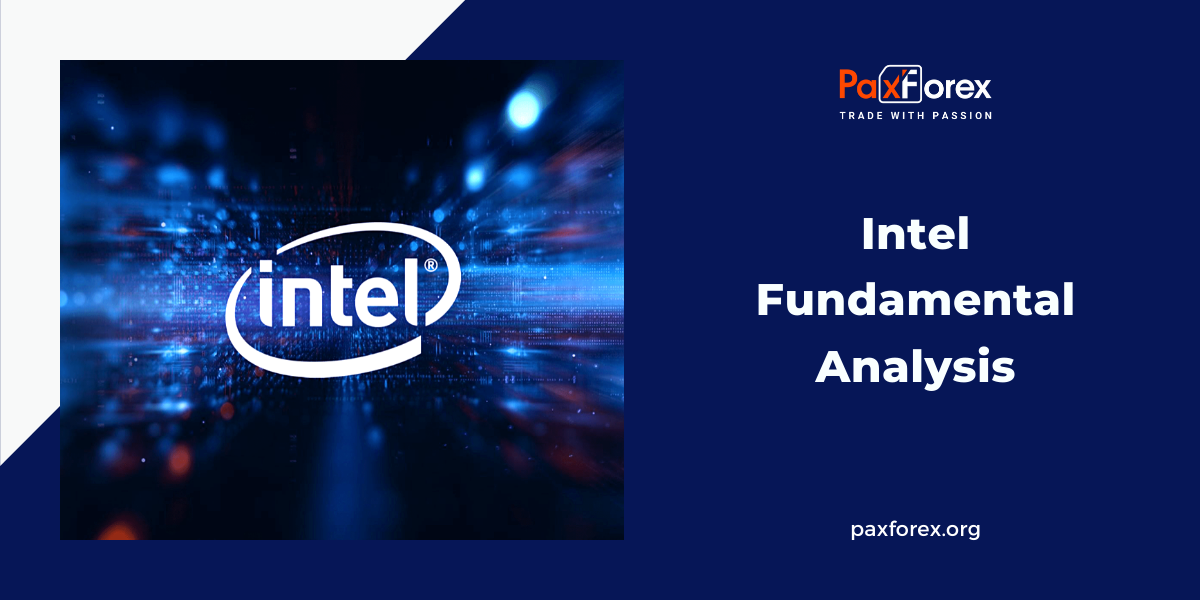
Source: PaxForex Premium Analytics Portal, Fundamental Insight
Intel has faced numerous challenges over the past decade. Once the dominant force in the chip industry and a preferred supplier for many tech companies, Intel has struggled to maintain its relevance amid increasing competition. As a result, its stock has declined by 40% since 2014.
Recently, however, Intel has started to make a comeback. The company has introduced a new line of AI-enabled chips, responding to the booming artificial intelligence (AI) market. These chips are priced significantly lower than those of its competitors, giving Intel a competitive edge. Additionally, Intel is refocusing on its manufacturing roots.
Over the past decade, Taiwan Semiconductor Manufacturing Company (TSMC) captured a significant portion of the foundry market. Now, Intel aims to reclaim its industry leadership by addressing the shortage of high-end chip manufacturing capacity in the US The company plans to build multiple plants domestically, potentially boosting its market share and capitalizing on the high demand for AI chips.
Despite this progress, Intel's recent earnings report has shaken investor confidence. The company's second-quarter 2024 earnings, released on August 1, missed Wall Street expectations, causing its share price to drop by 27% on Friday.
Nevertheless, Intel remains a compelling long-term investment. The company is pouring billions into the chip foundry market, a move that could yield significant returns in the long run. Therefore, despite recent setbacks, Intel's stock is still considered a buy for the latter half of 2024. Here's why.
Intel released its Q2 2024 earnings last Thursday, revealing a year-over-year revenue decline of just under 1%, falling short of expectations by $150 million. Non-GAAP earnings per share of $0.02 also missed the mark by $0.08. Adding to investor concerns, Intel announced the suspension of its Q4 dividend and plans to lay off 15,000 employees.
Despite these setbacks, it's essential to maintain a long-term perspective when investing in tech. Over the past year, Intel has made strategic moves indicating its commitment to future growth, even at the expense of current earnings.
For instance, increased production of Intel's AI-enabled Core Ultra PC chips contributed to the Q2 losses. However, CEO Pat Gelsinger emphasized that these trade-offs are worthwhile, projecting that AI PCs will grow from less than 10% of the market today to over 50% by 2026. Additionally, Intel CFO David Zinsner highlighted a shift in manufacturing from Ireland to Oregon for Intel 3 and 4 chip wafers, which is expected to incur higher immediate costs but result in wider gross margins over time.
Intel is also heavily investing in expanding its foundry capacity in the US, positioning itself to become the leading AI chip manufacturer in North America and Europe. While the manufacturing expansion is costly, it could provide a significant competitive advantage. Unlike Nvidia and AMD, which outsource their foundry needs, Intel's in-house manufacturing offers greater control and potentially more attractive operating margins.
Intel's manufacturing outlook is bolstered by its leading position in receiving financial support from President Biden's CHIPS Act. The company will receive an $8.5 billion grant and $11 billion in loans to build at least four chip fabs in the US, including a facility in Ohio aimed to be the world's largest AI chip factory. Rival TSMC will also receive funding to build a plant in Phoenix, but Intel's dual role in design and manufacturing could give it a significant edge in the market.
While Intel's shares experienced a sharp decline this month, making the current valuation more attractive for new investors. Intel is now one of the best-valued stocks in the AI chip market, with a lower price-to-earnings (P/E) and price-to-sales (P/S) ratio compared to some of the industry's leading companies. Intel's 12-month average P/E and P/S ratios of 67 and 3, respectively, indicate that the stock is trading at a more favorable value than it has in a year.
Considering its strategic investments and recent valuation, Intel remains a compelling chip investment for 2024, even after its recent slump.
As long as the price is below 22.00, follow the recommendations below:
- Time frame: D1
- Recommendation: short position
- Entry point: 19.69
- Take Profit 1: 17.00
- Take Profit 2: 14.00
Alternative scenario:
If the level of 22.00 is broken-out, follow the recommendations below:
- Time frame: D1
- Recommendation: long position
- Entry point: 22.00
- Take Profit 1: 24.00
- Take Profit 2: 26.00













